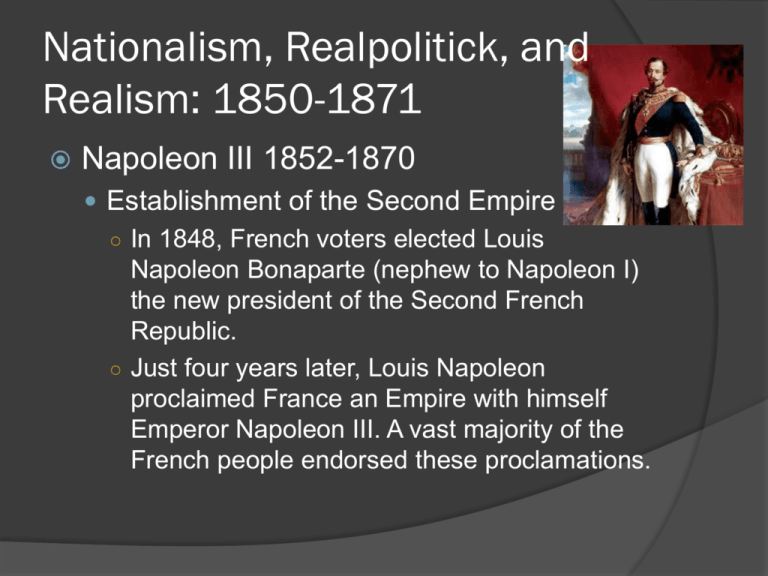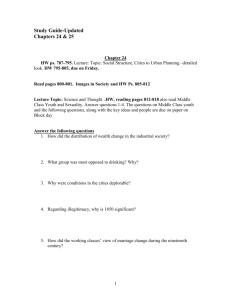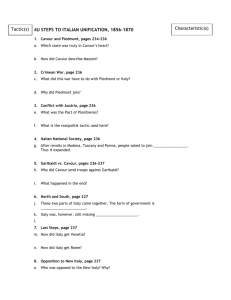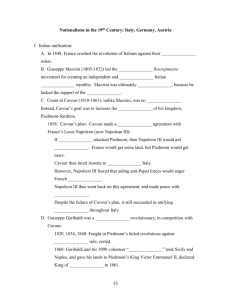Nationalism, Realpolitick, and Realism: 1850-1871
advertisement

Nationalism, Realpolitick, and Realism: 1850-1871 Napoleon III 1852-1870 Establishment of the Second Empire ○ In 1848, French voters elected Louis Napoleon Bonaparte (nephew to Napoleon I) the new president of the Second French Republic. ○ Just four years later, Louis Napoleon proclaimed France an Empire with himself Emperor Napoleon III. A vast majority of the French people endorsed these proclamations. Economic Progress ○ Napoleon III understood the importance of modern industrialization. His economic policies included the following achievements: Railroad mileage increased by more than fivefold. Moderate free-trade policies doubled exports. Industrial production doubled, enriching the middle class. ○ Napoleon did not ignore the working class. He legalized trade unions and improved public housing. Rebuilding Paris ○ Napoleon named Baron Georges Haussmann to oversee a vast project to redesign Paris. ○ Haussmann replaced narrow streets and congested working class neighborhoods with wide avenues, impressive public monuments, and expansive parks. ○ The rebuilding project accomplished several objectives: It transformed Paris into a symbol of France’s prosperity and greatness It made it much harder for rioters to blockade streets Quest for Glory ○ Napoleon believed that the Concert of Europe limited France’s foreign policy. ○ Napoleon was determined to follow a foreign policy calculated to undermine the Concert of Europe and win international glory for himself and for France. Tennyson ~ Charge of the Light Brigade ~ poem with text - YouTube The Crimean War, 1853 -1856 The Causes ○ A squabble over jurisdiction within the holy places in Turkish-ruled Jerusalem brought France (the protector of the Catholics) and Russia (the protector of the Orthodox) into diplomatic controversy with Turkey in the middle. ○ Tsar Nicolas I saw an opportunity to dominate Turkey and secure entrance into the Mediterranean through the Turkish Straits ○ Austria felt threatened by Russia’s expansion into the Balkans. ○ France and Britain opposed any change in the regional balance of power. The War ○ France, Britain, Turkey, and a contingent of 10,000 men from Piedmont-Sardinia captured the strongly defended Russian fortress at Sevanstopol. ○ The war claimed over 500,000 lives, most caused by disease and inadequate medical care. Horrible Histories Charge Of The Light Brigade - YouTube Consequences ○ The Crimean War marked the first great power conflict since the Congress of Vienna in 1815. ○ Napoleon III achieved his objective of breaking the alliance between Austria and Russia. ○ By entering the war on the side of France and Britain, Piedmont-Sardinia hoped to gain support for Italian unification ○ Russia’s humiliating defeat forced Alexander II to launch an ambitious program of reforms. Russia: Reaction and Reform Tsarist Russia in the 1850’s ○ Tsar Alexander II was an autocrat whose will was law. ○ Russia’s aristocracy continued to own almost all the land and be exempt from taxes. ○ Russia had a very small middle class. Ninetyfive percent of the people were peasants, most of whom were serfs. Alexander’s reforms ○ The Emancipation of the serfs, 1861 In 1861, Alexander II issued an Emancipation edict freeing the serfs. Although they were free, the peasants still did not own the land. ○ The creation of zemstvos In 1864, Alexander introduced a system of local and regional self-government through elected assemblies called zemstvos. Although the zemstvos did provide some opportunity for public discussion, they did not lead to the creation of a national assembly. The Unification of Italy The situation in 1850 ○ Repeated failures The Carbonari had failed to incite a successful revolution. Giuseppe Mazzini and the Young Italy Movement failed to rally support for a republic. ○ Continued obstacles Austria continued to control Lombardy and Venetia while also dominating other small Italian states. A reactionary Bourbon regime continued to control the kingdom of the Two Sicilies. Pope Pius IX opposed the cause of Italian nationalism. ○ Piedmont leadership Italian nationalists looked to the kingdom of Piedmont-Sardinia for leadership. It was the only Italian state ruled by an Italian dynasty. In 1852, Piedmont’s King Victor Emmanuel II named Count Camillo di Cavour his prime minister. Cavour and the Practice of Realpolitik ○ Realpolitik Early Italian nationalists such as Mazzini had been inspired by romantic ideals of nationalism. Cavour was a realist guided by the dictates of political power. He believed that shrewd diplomacy and well-chosen alliances were more useful than grand proclamations and romantic rebellions Cavour’s successful combination of power politics and secret diplomacy is called Realpolitik, “the politics of reality” Strengthening Piedmont ○ Cavour launched an ambitious economic program that included building railroads and expanding commerce. ○ Cavour modernized Piedmont’s army. The Franco-Piedmont alliance ○ Cavour understood that Austria was the greatest obstacle to Italian unity ○ Cavour formed an alliance with Napoleon III to drive Austria out of northern Italy. War with Austria, 1859 ○ The combined French and Piedmont armies defeated the Austrians. Meanwhile, Italian nationalists staged revolts across northern Italy. ○ Sardinia annexed all of northern Italy except for Venetia. Giuseppe Garibaldi and the Red Shirts ○ The pragmatic Cavour and the romantic Garibaldi agreed that Italy should be freed from foreign control. ○ While Cavour was uniting the north, he also secretly supported Garibaldi in the south. ○ In May 1860, Garibaldi and his small but zealous force of so-called Red Shirts successfully invaded and liberated the kingdom of the Two Sicilies. ○ Garibaldi agreed to step aside and let Victor Emmanuel rule the areas he had conquered. Persistent Problems ○ In March 1861, an Italian parliament formally proclaimed the kingdom of Italy with Victor Emmanuel II as king “by the grace of God and the will of the nation”. Tragically, Cavour died just two months later. ○ The newly unified kingdom of Italy faced a number of persistent problems: Unification was still not complete. Venetia remained under Austrian control and the papacy led by Pius IX remained hostile to the new Italian state. Northern Italy was urban, sophisticated, and increasingly industrialized. Southern Italy remained rural, backward and poor. (what does that remind you of?) The new government was burdened by a heavy debt, Test Tip: Cavour and Garibaldi are compelling historic figures who command interest and APEuro questions. However, don’t forget to study the often overlooked but still important problems that plagued the newly founded kingdom of Italy The Unification of Germany The Situation in 1860 ○ Obstacles to unity Germany remained politically divided into a number of small states that jealously guarded their independence. The German Confederation remained a loose grouping of 39 states dominated by Austria. French foreign policy continued to support German rivalries while opposing German unity. ○ Prussia’s growing strength Prussia’s population increased from 11 million in 1815 to more than 18 million in 1850 Led by Prussia, the Zollverein promotes German economic growth while demonstrating the advantages of unity. https://www.youtube.com/watch?v=j3k724JXPY&list=PLYxvwS-l0mdBgR6jK2b4gzS_cTMQkhyp&index=2 Otto Von Bismarck, Master of Realpolitik ○ In 1862, William I chose as his prime minister a Junker and staunch conservative named Otto Von Bismarck. ○ A master of Realpolitik, Bismarck set out to strengthen Prussia. ○ Bismarck enlarged and reequipped the Prussian army so that he could take advantage of opportunities for further territorial expansion. ○ Disavowing liberalism as frivolous and misguided, Bismarck firmly declared, “The great question of our day cannot be solved by speeches and majority votes – that was the great error of 1848 and 1849 – but by blood and iron. War with Denmark, 1864 ○ Bismarck led Prussia into war with Denmark to win two border provinces, Schleswig and Holstein. ○ The victory combined with shrewd diplomacy enabled Bismarck to begin the process of eliminating Austria from German affairs. Test Tip It has been said that only three people truly understood the controversy over Schleswig and Holstein. APEuro test writers do not expect you to be the fourth person tomaster this topic. As you study Bismarck and the wars with Denmark, Austria, and France, avoid getting bogged down in the details. Instead, focus on the consequences of each war. War with Austria, 1866 ○ The Seven Weeks’ War In 1866, Bismarck provoked Austria into declaring war on Prussia Prussia’s revitalized army easily crushed the Austrians in a brief conflict known as the Seven Weeks’ War. ○ Consequences Austria agreed to the dissolution of the German Confederation With Austria excluded from German affairs, Bismarck organized a North German Confederation dominated by Prussia As Prussia’s ally, Italy annexed Venetia War with France, 1870 ○ The Causes France feared the sudden emergence of a strong and aggressive Prussia. It is important to note that France had opposed German unity for centuries Bismarck adroitly exploited a minor dispute between France and Prussia over the search for a new Spanish monarch. By skilfully editing the Ems Dispatch, Bismarck inflamed relations between France and Prussia. Napoleon III declared war on Prussia on July 19, 1870 The war ○ The Prussians successfully invaded France and forced Napoleon III to surrender on September 2, 1870. ○ On January 18, 1871, King William I was proclaimed German emperor in the Hall of Mirrors at the Palace of Verailles. The consequences ○ Bismarck imposed a harsh settlement. He forced France to pay a huge indemnity and cede Alsace and most of Lorraine to the German empire. ○ The loss of rich deposits of coal and iron ore was a blow to France’s economy. The loss of these provinces was an even greater blow to French national pride. ○ The unification of Germany created a new European balance of power. As the German empire rapidly industrialized, it became the strongest state on the continent of Europe and a formidable rival to Great Britain. The Austrian Empire Defeat and Discontent ○ Austria suffered humiliating military defeats at the hands of first France and Piedmont and then Prussia. ○ The empire’s biggest problem was the discontent of the many nationalities living under Habsburg rule. ○ The Magyars were the largest ans most restive national group. The Dual Monarchy ○ In 1867, Austria agreed to satisfy the Magyars’ demands for independence by creating a dual monarchy. ○ Austria and Hungary became independent and equal states under a common Habsburg ruler. The two states still had a united army and a common foreign policy. The new empire was known as Austria-Hungary. The Continued Slavic Discontent ○ The dual monarchy satisfied the Magyars but failed to solve the empire's nationality problem ○ The Slavic regions called for but failed to receive a triple monarchy. ○ Slavic discontent posed a significant threat to the future of Austria-Hungary and the peace of Europe. Great Britain: Prosperity and Reform The “Workshop of the World” ○ Great Britain continued to enjoy unprecedented prosperity ○ British shipyards led the world in the construction of iron ships. ○ British bakers invested surplus capital in projects all over the globe. The Reform Bill of 1867 ○ Britain’s rapidly growing working class continued to demand electoral reform. ○ Led by Benjamin Disraeli, the Conservatives (formerly Tories) supported a new reform bill. ○ The Reform Bill of 1867 extended the suffrage to most of Great Britain’s urban workers. ○ It is important to note that British women were still denied the right to vote. Realism in Literature and Art Key characteristics ○ Disenchanted with romanticism ○ Focused on the daily concerns of real people such as workers and peasants ○ Criticized the cruelty of industrial life and the greed and insensitivity of the wealthy Leading Realist Authors ○ Charles Dickens, “Hard Times” ○ Gustave Flaubert, “Madame Bovary” ○ Henrik Ibsen, “A Doll’s House” ○ Fyodor Dostoyevsky, “Crime and Punishment” Leading Realist Artists Gustave Courbet, The stonebreakers Honore’ Daumier The Third-Class Carriage Edouard Manet, The Fifer




